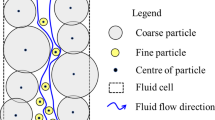Abstract
Considering the material non-uniformity and time-varying mechanics performance in seepage development of soil levee, the particle flow code (PFC) method and the fast Lagrangian analysis of continua (FLAC) approach are combined to implement the numerical analysis and evaluation for seepage behavior and its control effect in soil levee engineering. Based on the coupling characteristics of particle and water in soil levee, a PFC-based numerical simulation method of seepage development is introduced. To improve the accuracy and efficiency of above method, the soil particle generation technology according to soil grading curve is presented. An approach, which refers to geotechnical centrifuge test and similarity principle, is developed to build the scale model of prototype levee. The calculation restriction of PFC method, which is integrated into FLAC tool, is broken. Lastly, the numerical simulation for seepage behavior of one actual levee engineering with seepage control measures is implemented by the proposed method. The seepage control mechanisms of selected measures are analyzed. The macroscopic and mesoscopic effects of selected measures on different levee foundations are evaluated. It is indicated that the seepage control effect can be described more finely with the average coordination number and the vertical effective stress which are obtained by the proposed numerical method.





















Similar content being viewed by others
References
Bui HH, Fukagawa R (2013) An improved SPH method for saturated soils and its application to investigate the mechanisms of embankment failure: case of hydrostatic pore-water pressure. Int J Numer Anal Meth Geomech 37(1):31–50
Liu W, He S (2016) A two-layer model for simulating landslide dam over mobile river beds. Landslides 13:565–576
Li L, Pan Y, Amini F et al (2012) Full scale study of combined wave and surge overtopping of a levee with RCC strengthening system. Ocean Eng 54:70–86
Skempton AW, Bogan JM (1994) Experiments on piping in sandy gravels. Geotechnique 3(44):449–460
Kohno I, Nishigaki Y (1987) Levee failure caused by seepage and preventive measures. Nat Disaster Sci 9(2):55–76
Hori T, Mohri Y, Kohgo Y et al (2011) Model test and consolidation analysis of failure of a loose sandy embankment during seepage. Soils Found 51(1):53–66
Zhu Z, Ni X, Hu Z et al (2013) Mesoscopic damage quantification research of the deformation and failure of granite under circulatory load with different frequencies. Eur J Environ Civ Eng 17(1):321–333
Itasca (2005) Partical flow code, PFC2D, release 3.1. Itasca Consulting Group, Inc., Minneapolis
Anderson JR, John D (1995) Computational fluid dynamics: the basics with applications. McGraw-Hill, New York
Oda M, Iwashita K (1999) Mechanics of granular materials. Brookfield, Amsterdam
Stephance B (2008) The scaling law in the hole erosion test with a constant pressure drop. Int J Numer Anal Methods Geomech 32(13):102–115
Dong P (2001) Scaling laws for centrifuge modelling of soil transport by turbulent fluid flows. Int J Phys Model Geotech 1:41–45
Ni X, Wang Y, Wang F (2009) Simulation of particle flow code for similarity analysis of seepage deformation. J Civ Archit Environ Eng 31(3):55–60
Liuqian D, Wu M, Liu C (2007) Numerical simulation of dynamic development of piping in two-stratum dike foundations. Water Resour Hydropower Eng 38(2):36–39
Xikui WKL (2013) Bridging scale method for Biot-Cosserat continuum-discrete particle assembly modeling of unsaturated soil. Chin J Appl Mech 30(3):297–303
Itasca (2000) FLAC-fast Lagrangian analysis of continua (version 3.0). Itasca Consulting Group, Inc, Minneapolis
Cai M, Kaiser PK, Morioka H et al (2007) FLAC/PFC coupled numerical simulation of AE in large-scale underground excavations. Int J Rock Mech Min Sci 44(4):550–564
Acknowledgements
This research has been partially supported by National Natural Science Foundation of China (SN: 51739003, 51579083, 51479054, 41323001), the National Key Research and Development Program of China (SN: 2018YFC0407101, 2016YFC0401601, 2017YFC0804607), Key R&D Program of Guangxi (SN: AB17195074), Open Foundation of State Key Laboratory of Hydrology-Water Resources and Hydraulic Engineering (SN: 20165042112, 20145027612), the Fundamental Research Funds for the Central Universities (SN: 2018B40514, 2015B25414).
Author information
Authors and Affiliations
Corresponding author
Additional information
Publisher’s Note
Springer Nature remains neutral with regard to jurisdictional claims in published maps and institutional affiliations.
Rights and permissions
About this article
Cite this article
Su, H., Li, H., Zhang, L. et al. Particle flow code method-based seepage behavior analysis and control effect evaluation for soil levee. Engineering with Computers 36, 97–114 (2020). https://doi.org/10.1007/s00366-018-0687-2
Received:
Accepted:
Published:
Issue Date:
DOI: https://doi.org/10.1007/s00366-018-0687-2




